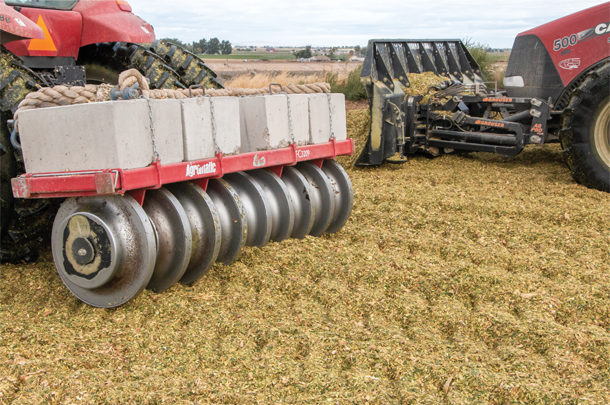There’s a lot of pressure on custom harvesters. In a small window of time, they are rushing to get multiple clients’ forages ensiled – often across many states with a dog-tired crew by the end of the season.
Errors occur where there’s pressure and exhaustion, and mistakes are never safe when there’s heavy machinery involved.
In fact, 50% of incidents reported to the Iowa Department of Public Health each year are during August, September, October and November. Does that time frame ring a bell?
Following are my tips for finishing each season with satisfied customers and safe employees. While these tips are specific to custom harvesters, they can be applied to any harvest situation.
Pre-harvest: Examine, repair, replace
Harvest timing depends on weather, which is out of our control. Let’s refocus on what we can control: preparing our equipment and our team.
- Examine all equipment. Make any repairs needed and replace anything worn, torn or broke.
- Make sure each machine is equipped with a working fire extinguisher. Fire is a common hazard in the harvest fields, especially during cereal grain harvest. Make sure each extinguisher is working and ready if you need it.
- Keep those safety shields on. They are annoying but are there for a reason. Shafts, belts, pulleys, beaters, etc., must be properly guarded to be safe. Plus, removing manufacturer safety shields may affect your insurance. Check your policy for details.
- Confirm emergency shut-off devices are maintained and in perfect condition.
- Check lighting on all equipment. Also, be sure to check reflective safety pieces, like triangles, on equipment.
Safety is important to consider during the pre-harvest period, too. Hydraulically raised equipment should be securely blocked before anyone works on, around or under the machine.
This is a perfect time to scout fields for obstructions or obstacles while you’re checking on maturity levels. It can help your team plan for areas that might be tricky – and leave those for experienced crew members.
During harvest: Safety first, then repairs
Repairs will need to be made during harvest despite our best efforts to prepare. Train your team on the proper way to make repairs:
- Turn off the ignition and put the key in your pocket. No exceptions. This applies to choppers, tractors and forage wagons.
- Stay away from exposed moving parts. Loose clothing – hoodie strings, also jewelry and ponytails, can be pulled in quickly.
- Never enter the forage wagon when it is running.
Repairing or unplugging operating machinery is dangerous. It is absolutely worthwhile to add a minute of time restarting the engine. Consider this: The intake of a baler is going 3 miles per hour or 4.4 feet per second. Snapping rolls on a cornhead pull in stalks at a rate of 12 feet per second. You simply cannot reach in to pull a stubborn stalk out and expect your human hands and mind to react at that speed.
Reducing human error
We can all make mistakes – especially when we’re tired, sleep-deprived or even sick after weeks of living on Dr. Pepper and potato chips. It is important to recognize your limitations as a human.
As an owner or manager, you must create a space that allows employees to tell you when they are exhausted or in over their head. The crew can take a few, short “microbreaks” during the day to refocus and recharge. It helps the teamwork be smarter.
Greenhorns, or new crew members, are often young adults. Besides being inexperienced, consider that they may lack the cognitive skill or physical ability to perform the tasks assigned to them. Their young minds aren’t fully developed yet.
Training prior to harvest can help, but it’s up to managers to make savvy task assignments. It will benefit both the safety of the operation and ensiling quality.
As tasks become routine, there is often the temptation for complacency to set in for all members of the crew. Guarding against complacency can help keep everyone safe, and – as a bonus – ensiling structures that are filled and packed safely help create high-quality feed, too.
Finally, it’s tough to be away from family for the length of harvest. However, young kids do not belong around machinery. It stinks, but be firm on this point.
Identify common mistakes
Take the time to explain to your crew why common mistakes are potentially dangerous. Talk about rollovers (the most common cause for injury or death) and overfilled trucks/wagons. Explain how each can be avoided.
If you will be harvesting after dark, ensure there is proper lighting around the pile. It’s hard to be safe if you can’t see well.
Establish a clear protocol for when truck drivers or dairy personnel approach the silo for a sample. Ideally, all pack tractors would stop until the individual clears the area or, at least, steer clear of where individuals are afoot.
Never get out of a pack tractor while on the pile. An essential rule-of-thumb is to know where every person is before putting a piece of equipment into gear.
Further, everyone on the team should wear high-visibility personal protection equipment gear. Dirt and dust during harvest dramatically minimizes visibility, leaving little room for error. Communicate about cellphone use and other distractions, especially for the trucking crew, where boredom can set in.
Reiterate the expectations for managing the self-unloading grain wagons and forage blowers:
- Unload wagons on a level surface. Don’t drive up on blocks to make wagons unload faster.
- Fasten the power takeoff (PTO) blower securely to the tractor. Vibrations could draw the equipment off-kilter, allowing the telescoping PTO shaft to separate and rotate dangerously.
- Never climb into the hopper or use hands/feet to force material into a blower.
Make communication about safety a priority
Daily safety reminders will help to ensure everyone on the custom harvest crew is aligned to complete the job well – and safely.
A culture of safety requires a commitment from each of us. Employees must be trained and able to do the job. Managers must work to prepare for success and commit to safety – so that when the pressure is on, our valuable machines can just “eat” to secure the year’s profit goals.










